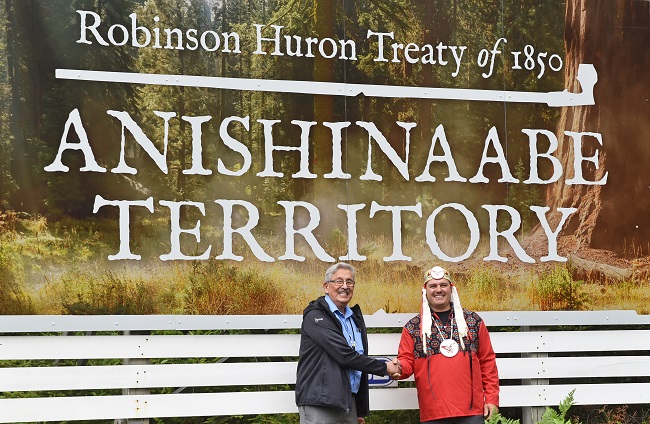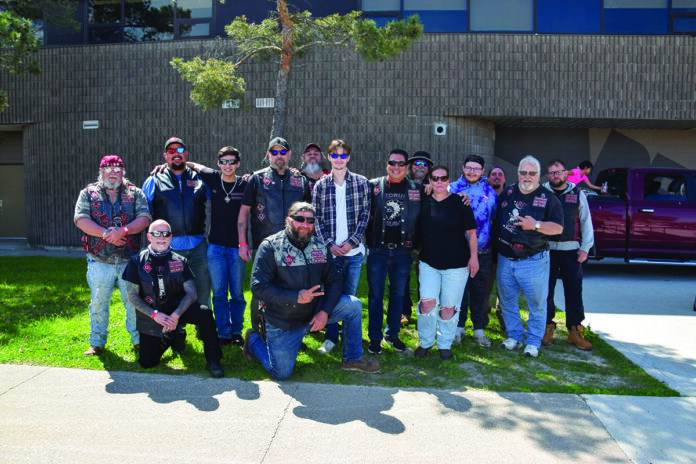ROBINSON-HURON—The Robinson Huron Waawindamaagewin (RHW), which includes 21 First Nations (including those on Manitoulin Island), passed a declaration that denounces the Metis Nation of Ontario (MNO) and its claims to Indigenous identity and its recognition as a self-governing Indigenous group by the government of Canada.
The declaration was passed in May, according to a news release issued by the group last week. Both RHW and all chiefs in the treaty territory contend there were no distinct historic Metis communities within Robinson-Huron Treaty territory when the treaty was signed in 1850.
“The declaration asserts the inherent rights and obligations of the Anishinaabe to RHW lands,” reads the release. “The spirit and intent of the Robinson-Huron Treaty is to share the benefits of the land; it does not include delegating jurisdiction to Canada to recognize or to enter into treaty with other groups in the territory.”
The declaration comes as Bill C-53, federal legislation tabled last year, would affirm Metis rights to self-determination and self-government in Ontario and Alberta if passed, and provide the backdrop for continuing criticism from First Nations groups concerned about land and resource rights being given to Metis groups without their consent.
“We have done extensive research whether there was Metis territory, and there were no Metis communities when the treaty was signed,” Earl Commanda, executive director of RHW told The Expositor. “They (Metis Nation of Ontario) are basing their claims that there were Metis around to enter into a treaty for territory. On the legislation being proposed we say no.”
“When you look at the issue of who is a Metis person, in the west, in Manitoba, Saskatchewan and Alberta, yes, there are Metis people and Metis Nations, but not in Ontario,” said Mr. Commanda. “We recognize Metis Nations and Metis people in Saskatchewan, Manitoba and Alberta, but not in Ontario. But for this (MNO) body to claim Metis Nation status, it impacts treaty rights for trapping, fishing and gathering. They enter into agreements with the MNRF (Ministry of Natural Resources and Forestry). This all effects on our Anishinabek rights and impacts our rights to hunt, fish and gather. MNO doesn’t have these rights.”
RHW chiefs recently conducted their spring gathering of chiefs in Assembly, held in Sudbury on May 15 and 16. Over two days, discussion took place on topics such as the environment, territorial land use and occupancy, government relations, and sovereignty. During the assembly, RHW Chiefs passed a declaration denouncing the (MNO), their claims of false Indigenous identity, and Canada’s recognition of the MNO as a self-governing group. “The declaration asserts the inherent rights and obligations of the Anishinaabe to RHW lands (referred to as N’daakimaan). The spirit and intent of the Robinson Huron Treaty is to share the benefits of the land, it does not include delegating jurisdiction to Canada to recognize or enter into Treaty with any other groups in the territory.”
“Robinson Huron Waawiindamaagewin Chiefs express that there are still many issues that need to be addressed, such as: Canada’s failure to seek RHW’s consent or consult with RHW Chiefs and their First Nations regarding jurisdiction and delegation of authority; Canada’s recognition of a concentrated group of mixed-blooded people as a Collective; the Collective’s acknowledgment of members that self-identify as Metis without reliable research methodology; the lack of recognizable society in the territory’s “historic Metis communities’ that signify nationhood (language, ceremony, culture); the MNO, a corporation representing the “Red River’ Metis living in Ontario, is falsely recognized as an organization that can negotiate self-government agreements; Canada’s flawed recognition of the MNO as a Nation capable of entering Treaty.”
“RHW chiefs strongly assert that there were no distinct Metis communities within RHW at the time of the signing of the Treaty in 1850,” said the release.
The RHW declaration passed by consensus on May 16 states in part, “The MNO is a corporation that was established in 1993 to represent the Red River Metis living in the Ontario region. The MNO evolved to represent individuals of mixed ancestry following the 2003 Supreme Court of Canada Powley decision and misapplied the Powley text to expand its membership. The MNO began making unfounded and egregious claims in First Nations ancestral and Treaty territories which led to the Chiefs of Ontario to terminate the 2004 Political Protocol with the MNO in 2010 due to MNO asserting alleged rights, which conflicted with established First Nation inherent and Aboriginal rights acknowledged by Treaty. RHW, the Chiefs of Ontario and the Manitoba Metis Federation, the National government of the Red River Metis, maintain that the ‘six new historic” communities represented by the MNO did not exist at the time of effective colonial control and therefore cannot be eligible to be recognized as having section 35 rights. There is ample expert academic research to support this position. The MNO does not meet or adhere to the national definition of Metis established by the Metis National Council in 2002.”
The Assembly of First Nations, which represents more than 600 chiefs across Canada, passed a resolution last year calling for the federal government to quash the legislation. The Anishinabek Nation, which represents 39 First Nations in Ontario, has also passed a similar resolution.
As was reported previously, the Metis Nation Saskatchewan pulled its support for Bill C-53 last month over concerns about the other two groups it recognizes. The Manitoba Metis Federation is also opposed to the extension of self-government to MNO, as they feel they don’t meet the definition of Metis.
The Manitoba Metis Federation (MMF) and the Chiefs of Ontario co-hosted Indigenous identify fraud summit in Winnipeg in May. Both organizations passed a joint resolution calling on the federal government to cease all negotiations with MNO, and for Ontario to quash the identification of the six new Metis communities.
The MNO issued a statement following the identify fraud summit. “It is deeply disappointing that we have reached a point where once firm allies cannot sit down and discuss the issues currently affecting our peoples,” said MNO president Margaret Froh in the statement. “Despite the MMF’s best effort to confuse and distract people from our achievements and rights recognition, and to undermine every Metis government, we stand strong in who we are and are singularly focused on supporting our citizens as their democratically elected Metis government.”
Over a decade long legal battle, more than a dozen judges have affirmed the existence of a rights-bearing historic Metis community in the Sault Ste. Marie region. The community also possesses a right to hunt protected by section 35 of the 1892 Constitution Act.





